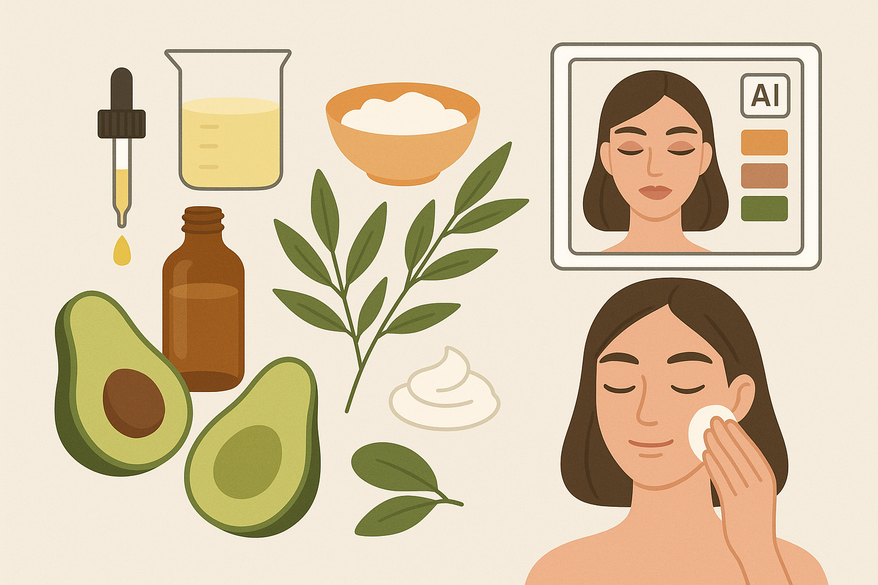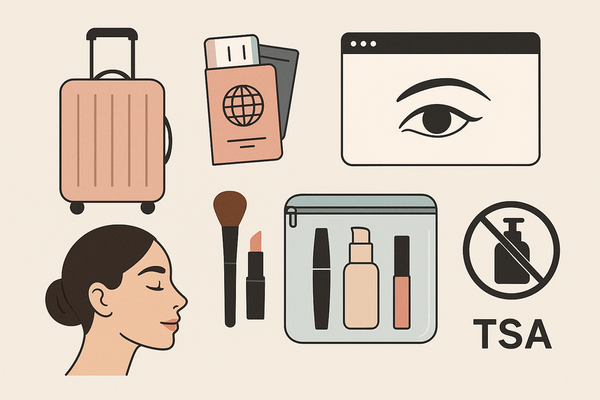DIY Natural Makeup Remover + AI Makeup Generator Tips
Learn how to create a DIY natural makeup remover with AI makeup generator tips for a customized, eco-friendly beauty routine. Discover nourishing ingredients and personalized solutions.

Estimated reading time: 7 minutes
Key Takeaways
- Use plant-based oils to effectively dissolve makeup while nourishing skin.
- Customize DIY remover recipes based on skin type, including dry, oily, and sensitive.
- AI makeup generators offer personalized ingredient ratios and real-time substitutions.
- Combining natural formulas with AI guidance creates an eco-friendly, cost-effective ritual.
- Patching, labeling, and proper storage ensure safety and product longevity.
Table of Contents
- Understanding Makeup Removal – DIY Natural Makeup Remover
- DIY Natural Makeup Remover
- Incorporating AI Makeup Generator in Beauty Solutions
- Benefits and Considerations – DIY Natural Makeup Remover
- Real-Life Applications: DIY Natural Makeup Remover
- Conclusion
- FAQ
Section 1: Understanding Makeup Removal – DIY Natural Makeup Remover
Makeup removal is a critical first step in any skincare routine. It clears away sebum, debris, and leftover makeup that can block pores and lead to acne or irritation.
Commercial Chemical Removers vs. Natural Alternatives
- Chemical removers often contain:
- Alcohols that strip natural oils
- Synthetic fragrances that irritate sensitive skin
- Preservatives that may trigger redness (Healthline)
- Natural removers use plant-based oils and extracts:
- Melt away makeup without aggressive rubbing
- Nourish the skin barrier with fatty acids and antioxidants
- Reduce risk of allergic reactions or over-drying (Viva Naturals blog)
Why Explore DIY Natural Makeup Remover?
- Gentler on skin—no stripping of moisture
- Customizable for your skin type and scent preferences
- Cost-effective and zero-waste: repurpose glass bottles and reusable pads
Section 2: DIY Natural Makeup Remover
Subsection A: Common Natural Ingredients & Benefits
Building your own makeup remover starts with simple, nourishing ingredients. Each component brings unique properties for cleansing and skin health:
- Coconut Oil
- Effectively dissolves waterproof makeup
- Provides deep hydration and fatty acids
- Lightweight and non-comedogenic for most skin types
- Olive Oil
- Rich in antioxidants (vitamins E and K)
- Supports skin regeneration and reduces fine lines
- Ideal for dry or mature skin needing extra moisture
- Jojoba Oil
- Closely mimics the skin’s natural sebum
- Balances oil production in both dry and oily skin
- Gentle enough for sensitive or breakout-prone skin
- Aloe Vera
- Soothes irritation and calms inflammation
- Delivers hydration without greasiness
- Contains vitamins A, C, and E for skin repair
- Witch Hazel
- Natural astringent with anti-inflammatory effects
- Helps tighten pores and control excess oil
- Works well on oily and acne-prone complexions
Subsection B: Step-by-Step DIY Recipe
Create a 6-oz bottle of makeup remover that’s balanced, gentle, and effective:
Ingredients:
- 1 tbsp jojoba oil
- 2 tbsp aloe vera liquid
- 2 tbsp witch hazel
- 3.5 oz distilled water
- 2 drops lavender or frankincense essential oil (optional)
Equipment:
- 6-oz glass or PET bottle
- Funnel for easy filling
- Measuring spoons
Instructions:
- Add jojoba oil to your bottle first.
- Pour in aloe vera liquid and witch hazel.
- Add essential oil drops if desired.
- Top off with distilled water.
- Secure the cap and shake gently before each use.
- Application: Soak a cotton pad, wipe your face gently—eyes included—then rinse or follow with your regular cleanser for a double-cleanse finish.
Subsection C: Customization Tips
- For Dry Skin
- Increase coconut oil to boost moisture retention
- Add a drop of rosehip oil for extra fatty acids
- For Oily/Acne-Prone Skin
- Raise witch hazel content for oil control
- Stick to lightweight oils like grapeseed or jojoba
- For Sensitive Skin
- Skip essential oils to minimize irritation
- Always perform a patch test; wait 24 hours to check for reactions (Healthline)
Section 3: Incorporating AI Makeup Generator in Beauty Solutions
An AI makeup generator is a machine-learning tool that tailors cosmetic formulas and routines based on your unique profile. By analyzing inputs like skin type, concerns, and ingredient inventory, AI can recommend personalized blends and step-by-step guidance.
Key AI Applications for Makeup Removal
- Personalized Recipe Generation
- AI assesses your skin hydration, sensitivity, and weather factors to craft a custom oil/extract ratio.
- Example: Suggesting 1.5 tbsp jojoba and 1 tbsp olive oil for combination skin.
- Ingredient Substitution Advice
- Offers real-time swaps when you lack a specific oil or extract.
- Example: Swap olive oil for avocado oil if you’re allergic to olives.
- Interactive Guidance
- Virtual tutorials with prompts and timers for proper emulsification and application.
- AI chatbots troubleshoot issues like stinging or excessive greasiness.
For more on AI makeup apps, see AI Makeup App Routine.
Platforms like Makeup Check AI integrate AI makeup generation and analysis into your beauty toolkit.
Section 4: Benefits and Considerations – DIY Natural Makeup Remover
- Advantages of DIY Natural Makeup Remover
- Nourishing, skin-barrier-friendly ingredients (Healthline)
- Fully customizable for dry, oily, combination, and sensitive skin (Viva Naturals blog)
- Cost-effective and zero-waste—reuse bottles and cotton rounds
- Eliminates harsh chemicals and reduces environmental impact
- Advantages of AI Makeup Generator Integration
- Hyper-personalized formulations based on AI analysis
- Simplified ingredient choices and precise ratios
- Interactive tutorials boost user success and consistency
Section 5: Real-Life Applications: DIY Natural Makeup Remover
“Switching to my DIY natural makeup remover cut down my breakouts in two weeks,” reports a user who swapped store-bought wipes for a jojoba-aloe blend. Dermatologist Dr. Lisa Peck recommends rotating carrier oils seasonally—lighter oils like grapeseed in summer, richer coconut or avocado oils in winter—for balanced hydration.
Pro Tips & Hacks
- Use soft, reusable cotton rounds to reduce environmental impact (Healthline).
- Add 1–2 drops of tea tree oil for antibacterial action, if tolerated.
- For waterproof mascara, press the soaked pad on closed lids for 10 seconds before sweeping down.
- Double-cleanse: oil cleanse first, then follow with a gentle foaming cleanser to remove residue.
Troubleshooting
- Feels too greasy? Reduce oil content by 0.5 tbsp or follow with a water-based facial wash.
- If stinging or redness occurs, eliminate essential oils and test a plain carrier-oil base.
- Cloudy or foul-smelling mix? Discard and mix a fresh batch—always use distilled water and clean equipment.
Conclusion
Crafting your own DIY natural makeup remover using jojoba oil, aloe vera, and witch hazel is simple, cost-effective, and kinder to both your skin and the planet. Pairing these gentle formulas with an AI makeup generator elevates personalization—AI suggests smart ingredient swaps, calculates precise ratios, and offers real-time guidance. Remember to patch test, label your blends, and store them properly. Experiment safely, adjust to your skin’s changing needs, and share your favorite custom formulations. For more expert advice on makeup removal routines, check out Best Makeup Remover Tips. Have you tried AI-driven beauty tools or created a signature remover? Let us know in the comments below!
FAQ
- Can I use coconut oil if I have oily skin? Yes, but you may prefer lightweight oils like jojoba or grapeseed to avoid excess greasiness.
- How long does DIY makeup remover last? Store in a cool, dry place and use within 6–8 weeks. Discard if the mixture turns cloudy or develops an odor.
- Do I need to double-cleanse? Double-cleansing ensures all residue is removed, especially waterproof makeup. Follow the oil cleanse with a gentle water-based cleanser.
- Is AI makeup guidance safe? AI tools offer personalized recommendations, but always patch test new ingredients and consult a dermatologist for specific concerns.




